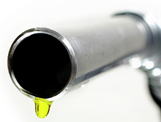| ||||||
| 1 | If you are thinking of buying a new car, go for a car that consumes less fuel. (They don’t always have to be small and light, but a SUV definitely will not fit the description.) |
| ||||
| 2 | Service your car regularly. Dirty air filters, worn spark plugs, etc. can affect fuel consumption. | |||||
| 3 | Maintain correct tyre pressure. (Your car’s manual will tell you what it is.) Safety aspect aside, your car will need more power (and consequently will use more petrol) to pull away and to accelerate if the tyres are incorrectly inflated. | |||||
| 4 | Ease the burden. Remove the roof rack, the bike rack, and anything heavy that you drive around in your boot all the time, but need only occasionally, like golf clubs, a crate of beer, bowling kit, etc. | |||||
| 5 | Drive smoothly, without sudden braking or accelerating suddenly. | |||||
| 6 | Maintain correct distance. Driving too close to the car in front is bad both for your safety and for your petrol consumption, because you are more likely to brake and accelerate suddenly. | |||||
| 7 | Don’t speed. Cutting your average speed will significantly affect your petrol bill. Plus, just think about all those speeding tickets you’ll save on too! | |||||
| 8 | Shift well in order to save some petrol. If you have a manual transmission, listen to your car. It will tell you the right time to change gear. Owners of automatic cars will keep their wallets happy by using cruise control whenever appropriate, keeping the RPM down when driving and shifting into neutral when idling. | |||||
| 9 | Air conditioning reduces fuel economy, so don’t use it unless you have to. When driving in a city (meaning, at moderate speed), roll down the windows just a little, so that the air can circulate through the car. If you have to use the AC, turn if off about five minutes before you reach your destination, and try to park in a shade. Never have the AC on and the windows open: that is a real waste! | |||||
| 10 | Close your windows when driving at high speed, because wind resistance makes the car work harder and use more petrol. | |||||
| 11 | Don’t use the long headlights (unless you really have to). Every piece of electrical equipment increases the demand on the engine to produce more power. Besides, do you know how annoying those brights are for the oncoming traffic, the car in front of you, and about everybody else? | |||||
| 12 | Avoid traffic jams. One option is to try to find alternative routes. If you have some flexibility at work, opt to start and leave half an hour before everybody else. | |||||
| 13 | Buy a map. Or ask for directions. Driving around in search of your destination is the surest way to empty that tank. | |||||
| 14 | Fill your tank when it’s half empty. Petrol evaporates fast, and the more air you have in your tank, the faster it will evaporate. Do it early in the morning, when the ground is still cool, because that’s when the fuel is at its densest. Oh, and if you see a truck delivering petrol – drive off and come the next morning. | |||||
| 15 | Make sure your fuel tank cap closes tightly, or you will lose a small oil field in evaporated petrol. | |||||
| And if you want to save even more... Well, walking about half a kilometre to the shop, propelling yourself on your bicycle to and from work every now and then, or enjoying the company of colleague who is willing to go splits on the petrol bill – all those are excellent ways to vary your routine, help your environment, and save on petrol! |  | |||||